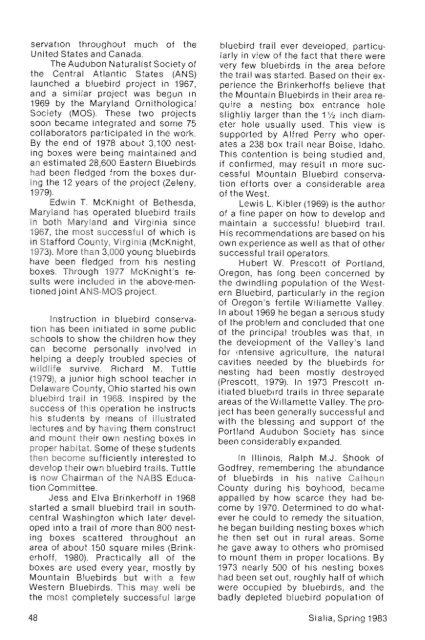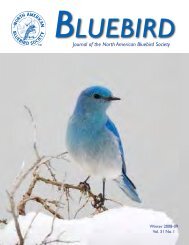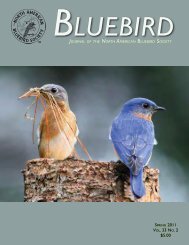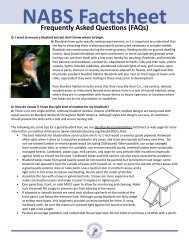Vol. 5, No. 2; Spring 1983 - North American Bluebird Society
Vol. 5, No. 2; Spring 1983 - North American Bluebird Society
Vol. 5, No. 2; Spring 1983 - North American Bluebird Society
Create successful ePaper yourself
Turn your PDF publications into a flip-book with our unique Google optimized e-Paper software.
servaticn throu gh out mu ch of th e<br />
United Stat es and Can ada.<br />
The Audub on Naturalist Societ y of<br />
th e Cent ral Atlantic State s (ANS)<br />
laun ched a bl ue bir d project in 1967,<br />
and a similar pro ject wa s begun In<br />
1969 by th e Maryland Ornithologi cal<br />
Soc iety (MOS). These two proj ects<br />
soon becam e int egrated and some 75<br />
collaborato rs parti cipat ed in th e wo rk.<br />
By the end of 1978 ab out 3,100 nesting<br />
boxes were being maintained and<br />
an estimated 28,600 East ern <strong>Bluebird</strong> s<br />
had been fledged from the boxes during<br />
the 12 years of th e proj ect (Zeleny,<br />
1979).<br />
Edwin T. McKn ight of Bethesda,<br />
Maryland has op erated blu ebird trails<br />
in both Maryla nd and Virgin ia sin ce<br />
1967, th e most successfu l of w hich is<br />
in Stafford County, Virginia (McKnight,<br />
1973). Mo re tha n 3,000 young bluebirds<br />
have been fl edged fro m hIS nest ing<br />
boxes. Through 1977 McKnight's results<br />
were inc luded in the above-me n<br />
tioned jo int ANS-MOS project.<br />
Instructio n in blu ebird c onservation<br />
has been initiated in some public<br />
sch ools to show th e children how th ey<br />
can becom e person all y involved in<br />
helping a deeply tr oubled spec ies of<br />
w ildlife survive. Richard M. Tuttle<br />
(1979), a junior hi gh sc hool teacher in<br />
Delaware County, Ohio sta rted his own<br />
bluebi rd tr ail in 1968. Inspired by th e<br />
success of th is opera ti on he instruc ts<br />
his students by means of illustrated<br />
lectures and by having them construct<br />
and mount their ow n nesting bo xes in<br />
pro per habitat. Some of th ese stud ent s<br />
then become su ffic ientl y interest ed to<br />
develop th eir ow n bluebird tr ai ls. Tuttle<br />
is now Chairman of the NABS Education<br />
Committee.<br />
Jes s and Elva Brin kerh off in 1968<br />
starte d a small bluebi rd trail in southce<br />
ntral Washing ton w hich later developed<br />
into a tr ail of more tha n 800 nest <br />
ing boxes sc attered thr oughout an<br />
area of about 150 square m il es (Brinkerhoff<br />
, 1980). Practically all o f the<br />
boxes are used every year, mostly by<br />
Mountain <strong>Bluebird</strong>s but w ith a few<br />
Western <strong>Bluebird</strong>s. This may well be<br />
the mo st co mplet ely successful large<br />
48<br />
bl uebird t rail ever developed, parti cula<br />
rly in view of the fact that th ere were<br />
very f ew blueb irds in th e area befo re<br />
th e tra iI was sta rted. Bas ed on th eir ex·<br />
perience the Brinkerh offs belie ve that<br />
the Mountain Blu ebird s in th eir area requ<br />
ire a nest in g box ent rance hol e<br />
slig htly larger than the 1'/2 inc h di ameter<br />
hole usually used. Thi s vie w is<br />
s uppor ted by Alfred Perry who op erates<br />
a 238 box trail near Boi se, Idah o.<br />
Thi s contention is being studied and ,<br />
if confirmed, may result In mo re successful<br />
Mountain <strong>Bluebird</strong> conservati<br />
on efforts over a co ns ide rable area<br />
of the Wes t.<br />
Lewi s L. Kibler (1969) is the aut hor<br />
of a fine pap er on how to develop and<br />
maintain a success ful bluebird tr ai l.<br />
His reco mm endation s are based on hi s<br />
own exper ie nce as well as th at of other<br />
succ essful trail operators.<br />
Hubert W. Presco tt of Port land,<br />
Oregon , has ran g bee n co nce rned by<br />
th e dwindl in g population of th e West·<br />
ern <strong>Bluebird</strong>, particul arly in the regi on<br />
of Oreg on's fert ile W il lamette Vall ey.<br />
In about 1969 he began a seri ous study<br />
of the prob lem and conc luded th at on e<br />
of th e principal troubles was that, in<br />
th e devel opment of th e Vall ey's land<br />
fo r In tens ive ag riculture, the natural<br />
c avities needed by th e bluebirds for<br />
nesting had been mo stly destroyed<br />
(Presc ott , 1979). In 1973 Prescot t initiat<br />
ed blu ebird trails in th ree separat e<br />
are as of th e Willamette Vall ey. Th e project<br />
has been generally successful and<br />
with th e ble ssin g and support of the<br />
Portland Audubon Soc iet y has since<br />
been co ns iderably expa nded.<br />
In Ill inois, Ralph M.J. Sho ok of<br />
Godfrey, remembe rin g th e abundance<br />
of blu ebirds in his nati ve Cal houn<br />
Cou nt y dur ing his boyhood, becam e<br />
app all ed by how sca rce they had become<br />
by 1970. Det erm ined to do w hatever<br />
he cou ld to remedy the Situation,<br />
he began bui ldi ng nest ing boxes which<br />
he th en set out in rural areas. Som e<br />
he gave aw ay to others w ho prom ised<br />
to mount them in prop er location s. By<br />
1973 nearl y 500 of hi s nesting boxes<br />
had been set out, rou ghl y half of which<br />
were occupied by blu ebirds, and the<br />
badly depl et ed bl uebird population of<br />
Si ali a, <strong>Spring</strong> <strong>1983</strong>





